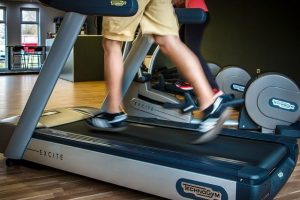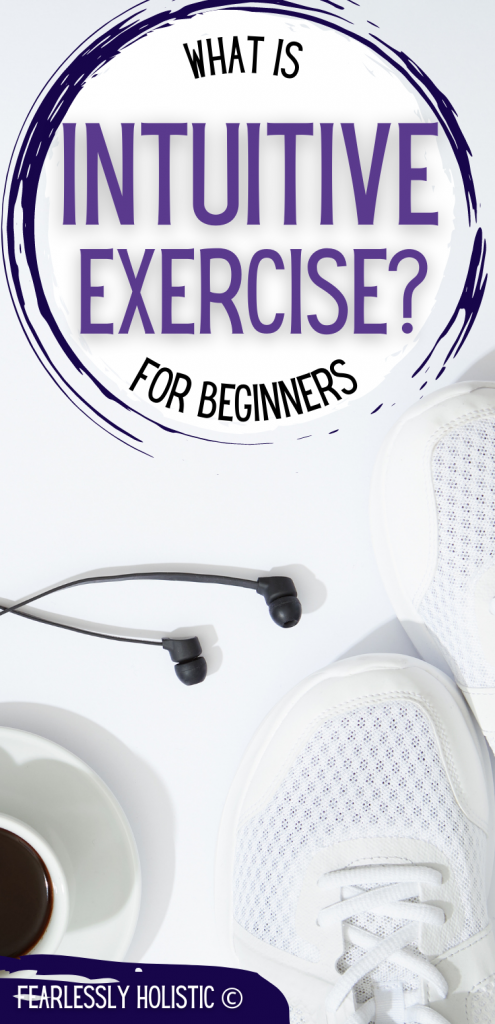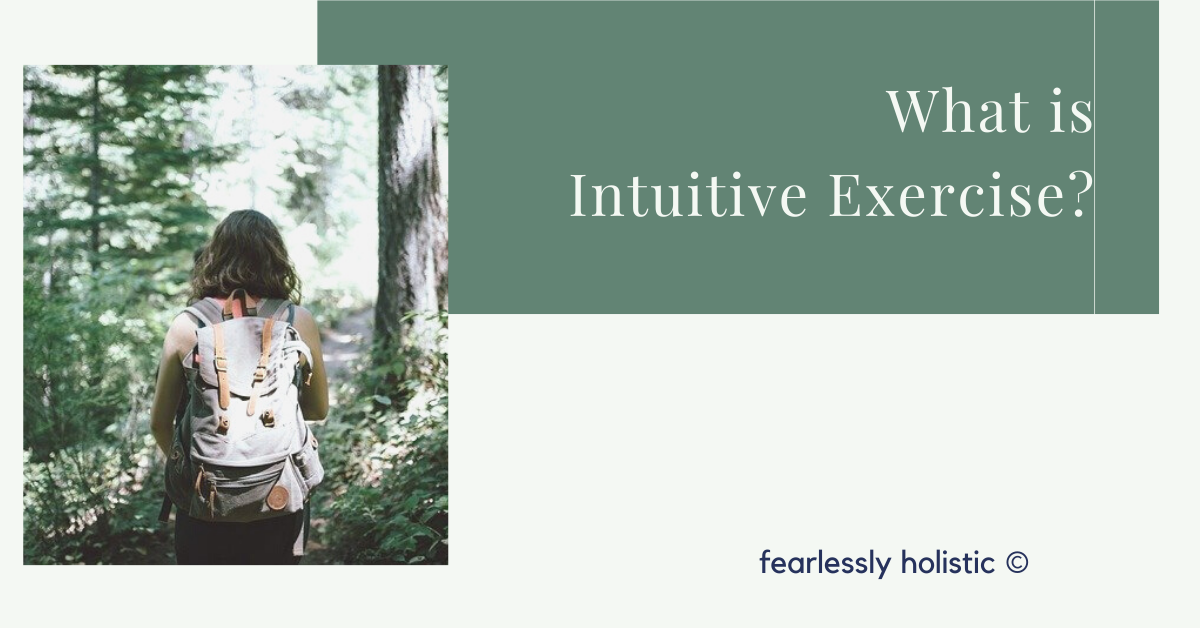Intuitive exercise, or movement, is a part of switching to an intuitive lifestyle. If you are ready to give up on the “conventional” health advice, and possibly disordered exercise habits, you may be ready to give your intuition a try.
You will likely want to honor your body by using your intuition as you choose how to move it, so let’s look at how to get started with that.
Hello and welcome to Fearlessly Holistic.
My name is Irma and I want to share my journey to improved health by eating whole foods, moving my body and eliminating stress as much as possible.
It is my hope to inspire you to make daily changes. Why? Because eating fresh, seasonal food, getting some sunshine, and purging unhelpful thinking is the best way to increase longevity. But you do not want just a long life.
You want a quality long life.
My blog posts are my opinion and the results of things that I have tried that either worked for me or didn’t. My opinions are for informational purposes only and are not intended as medical advice. Medical advice should always be obtained from a qualified medical professional for any health conditions or symptoms associated with them. As well, there may be affiliate links in this post. Read more here.
4 Signs of Disordered Exercise Habits

If you are on a journey of self-discovery and working on using your intuition for other areas of your life, you may want to know about intuitive exercise and how it can help you.
There is nothing inherently wrong with following a fitness plan, but for some people, that can lead to disordered exercise habits.
Exercise in and of itself is not a bad thing.
Where it can take a wrong turn is if you do not listen to your body and push it to do things that do not improve your life.
Here are some signs that your relationship with exercise is unhealthy, making intuitive exercise even more important for you.
1. You Use Exercise to Compensate for Eating and Lifestyle Choices
When you use exercise more to “make up” for what you eat or for not having what you think is an ideal healthy day, you have a disordered habit.
Exercise should never be used as punishment for what you have eaten, or a lack of physical activity in the hours, days, or weeks leading up to your workout.
You want to change how you view exercise into something you are doing for energy, health, and wellness. That’s it. Not to burn more calories and not to just force yourself into a lifestyle because that’s what you think you should be doing.
FYI: Exercise is something that we can do to tone up, get fresh air, and feel energized. Studies show that exercise is an ineffective for weight loss compared to eating healthier. Read this article from Vox.
2. Your Exercise Feels Forced and Mandatory
Another way you might have a bad relationship with exercise is when you always feel like you have to exercise, not like you want to.
You know yourself better than anyone, so you know when you are working out because you want to, and when it is because you think you need to.
Don’t ignore these feelings! They are important on this intuitive exercise journey.
3. You Feel Guilt or Shame When You Miss a Workout
Have you ever planned a certain workout, and when you couldn’t complete it, you felt immense shame or guilt? Did you beat yourself up for it and try to make it up during the next workout?
This is definitely a sign of disordered exercise habits.
Missing a workout is just missing a workout. That’s it. It’s not about being lazy or unmotivated, and it certainly isn’t going to harm your health.
Being intuitive is not just choosing the right exercise, but choosing when to skip it.
4. You Exercise in Unhealthy Conditions
Some people find that they will stick to their exercise routine regardless of cramps, pain, or illness.
If this is you, it might actually be a bad relationship with exercise, not just “commitment”. Think about when you forced yourself to workout when you were sick, had muscle cramps, or a really bad headache.
These are times when you should be resting, not pushing yourself to finish a high-intensity workout.

Intuitive Living is All About Trust
Intuitive living encompasses every area of your life where you want to be intentional, without being obsessive.
You want to honor your body, pay attention to your needs, and not over-complicate things or be too restrictive.
What being intuitive comes down to is trust. Trust in your body, trust in your own signals, trust in your entire health and wellness journey.
*Keep in mind that a lot of conventional health and weight loss advice is driven by product sales, not proven health benefits.
Trust Your Body
The first thing you will learn to trust in the intuitive living journey is your body. Your body will tell you what to eat and when to eat, as well as what types of exercise will make you feel the best in the moment.

Trusting your body is the first step to an intuitive lifestyle, as being more intuitive with your choices can feel like a big gamble.
If you have already started intuitive eating, then you have gone through this experience.
You no longer track what and how much you eat, how many calories you burn, or even the nutrients you are consuming.
In the beginning, this can feel really scary as you worry about “losing control” and gaining weight without ever stopping.
You just need to pause, and understand that your body knows what to do to keep you healthy, as long as you can listen to it and trust it.
Trust Your Intuition
You also have intuition that is further going to help you make healthy choices every day, but it requires a lot of trust.
Not only do you trust your body during this process, but you trust your mind.
Your mind is going to guide you in the right direction, where you intuitively know what to do in any given moment.
The more you practice mindfulness, journal your thoughts, and pay attention to how you feel, the more your intuition will tell you and guide you in the right direction.
This can take time, so do not expect miracles to happen in your first week.
Most of us have been programmed to believe that “other people” (the so-called experts) know what is best for us. Nothing could be further from the truth.
The side benefit of trusting your intuition is that you will see benefits quicker. Not rock hard abs benefits, but other improvements to your health, like improved mental health or an increased feeling of wellness.
Trust Your Wellness Journey
Having trust in this journey to be more intuitive and come out the other side a healthier, more balanced person is vital to your success.
This is what is going to help prevent you from falling back into bad habits and restrictions.
Throughout this journey, keep checking in with yourself. Make changes as needed, and look into yourself to see what your body and mind need the most.
Do not be afraid to drop an exercise, add something new or different or just generally do whatever your body signals for you to do.
Some days, this might mean releasing endorphins through a run, and other days you might find that a short stretching routine is best for your aching muscles.
Learn how to Listen to Your Body’s Signals
When it comes to intuitive exercise, sometimes called intuitive movement, you will need to really learn and pay attention to your body’s signals.
It’s not always easy, but before long, you will know exactly what form of movement your body wants at any given time, but also when it’s time for rest.
Here are some helpful tips to learn how to listen to your body’s signals.
Ask Yourself WHY You Want to Exercise
To listen to your body’s signals and understand what type of exercise would help you feel the best, you want to start with asking yourself why you want to exercise.
The reason this is important is to make sure you want to move your body for the right reasons.
Many New Year’s resolutions fail because people choose their resolutions because they are told that they should. They mark it on a calendar “January 1st…start jogging.”
If you do not understand why jogging is important for you, then you will not be motivated to keep doing it.
You will notice that you do this a lot throughout your intuitive living journey.
When it comes to health, you have to listen to your body’s signals and trust your intuition. Before you start an exercise, pay attention to what your mind is telling you and why you are choosing to exercise in that moment.
You can even write it down if that helps.
Do a Full Body Scan
The full body scan is one of the best ways to start tuning in to your body’s signals. Your body tells you a lot throughout the day, but if you aren’t paying attention, you will never notice. This is where the full body scan comes in.
Start your body scan at the top of your head.
Pay attention to each part of your head, face, neck, and shoulders, then work your way down.
You want to try to feel each body part as you mentally move down your arms, wrists and hands, your chest, back and torso, your legs, all the way down to your feet.
- Do you have muscle cramps?
- Are your joints aching to be stretched?
- Or do you feel like you want to work on your muscles, or do some cardio for energy?
Use Mindfulness
Mindfulness is going to help you with that full body scan, but also just to be more aware of how you feel during different times of the day.
Mindfulness should be considered a practice, where you do it a little each day, and gradually get better at it.
Before too long, you will be focusing on how you feel consistently during each activity and moment of your day, without really having to think about it.
Does a Thought or Activity Make You Feel Pumped?
Another easy way to know what kind of exercise your body wants or needs is to think about any form of movement, and see how it makes you feel or where your thoughts go.
Sometimes, you might think of an exercise, like Pilates, and it sounds uncomfortable and miserable. That’s how you know it’s not the one to do right now.
But maybe when you think of doing kickboxing, it sounds exciting and like it would give you energy. That is a good indication that you have found the one to participate in at that moment.
Why Should You Exercise Intuitively?
You may have a rough idea of what intuitive movement is, but why is it recommended?
Intuitive exercise is a part of intuitive eating and developing a healthier relationship with your body.
It is a way to transform your lifestyle into one of balance for ultimate health and fulfillment, both physically and mentally.

This is an Intuitive Eating Lifestyle
A big reason why exercising intuitively is so important is because it helps with an overall intuitive lifestyle.
Maybe you have been eating intuitively for a while to stop dieting, but are getting stuck when it comes to your workouts.
One of the major tenets of an intuitive lifestyle is gentle movement. Low impact yoga is a good example, because you want to take care with your joints.
Gentle movement can eventually turn into intuitive exercise, that helps you work more on living a life of health, balance, and being more mindful.
It Helps Build a Healthy Relationship with Your Body
Having a healthy relationship with your body is vital to respecting it and taking good care of it.
No more punishing your body, hating it for how it looks, or looking at other bodies and wishing yours looked like that.
This is the only body you are going to live in, so it is best to make a pact right now to be intuitive in how you take care of it, so that it lasts a long time.
4 Health Benefits to doing intuitive exercise
You will get better sleep
With intuitive exercise, you are more likely to do exercises your body needs, which can help you sleep much better over time.
It helps to reduce your anxiety
You may also notice that you start to enjoy exercise more, and do forms of movement that reduce your anxiety.
You get better strength and flexibility
Naturally, exercise is going to help a lot with your strength and flexibility, but it has an interesting effect when you follow your body’s cues. You enjoy how it feels, as opposed to how it looks.
It takes away the stress of weight loss
Many times, people don’t get the benefits of endorphins from exercise because they are so concerned with losing weight and burning calories.
When that is off the table, your only focus will be on how you feel, so suddenly the stress relief benefits are increased.
Getting Started With Intuitive Exercise
Check out your local colleges, fitness centers, and Yoga centers and see what they offer for classes. Do some research into anything that is new to you or that you may not fully understand.
Consider anything interesting or fun that strikes your fancy and check it out. See if they have a free introductory class.
Or if you have a friend taking a class, see if they have a visitors discount or “2-for-1” rate for new or interested students.
Or just start out walking in your neighborhood. You can use an app like Map My Run to create a route to see how far you walk your first day.

You Listen to Your Body When it Comes to Exercise
The first “rule” of intuitive exercise is that you listen to your body.
While you can still have a rough outline of the type of workouts you want to do, such as local fitness classes, you still want to be more in tune with your body and what form of movement you feel like doing.
This means if you had planned to go to a body sculpting class at the gym, but your muscles are sore, listen to your body and do something a little more gentle.
Sometimes, it means skipping the workout entirely to let your body rest.
You No Longer Have a Strict Fitness Routine
This is going to depend on your lifestyle and goals, but for the most part, exercising intuitively is no longer about having a strict schedule or routine you must stick to.
If you have ever been on a diet or weight loss program before, you know what this looks like.
You were probably given a schedule to adhere to, possibly multiple workouts each day, for 5-6 days a week. It might even have told you what time of day to do the workout and how many calories to burn during each workout.
This is no longer part of your lifestyle when you decide to switch to more intuitive forms of exercise.
Weight and Body Control is Off the Table
This can be a hard one for people to accept, but in order to really be in tune with what your body needs as far as exercise goes, you have to let go of your “body goals”.
It doesn’t mean you won’t get stronger and leaner and that your body won’t change, but you don’t pay attention to it as much.
No more weighing yourself, before and after photos, or looking at body goals images on Pinterest for inspiration. Your motivation will be health and wellness, not weight loss or changing your body.
Conclusion
Next week, we will further explore this topic by adding in the mindfulness component. Mindfulness is being in “the moment”, so not thinking about what you will do next but rather what you are doing right now.
Not only does it make exercise better, it improves your mental health at the same time! Watch for that post next week.
Holistic approaches never just address symptoms of specific health problems, but instead aim to return or keep the patient in a state of balanced health between mind, body, and spirit. Holism targets overall wellness, and when we are well, we only get better with age.
Please share this post with anyone who can benefit from it. Sharing is caring!
And follow me on Pinterest!
Until next time, here’s to our health!
-Irma
